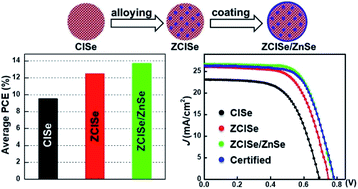Quantum dot materials engineering boosting the quantum dot sensitized solar cell efficiency over 13%†
Abstract
The intrinsic electronic structure and crystalline quality of quantum dot (QD) light-harvesting materials are among the primary reasons for determining the photovoltaic performance of the resulting QD sensitized solar cells (QDSCs). Undoubtedly, exploiting appropriate high-quality QDs is a crucial route to improving the performance of QDSCs. In order to reduce the density of trap state defects, a ZnSe shell layer with a wider bandgap is overgrown around the light-harvesting star material Zn–Cu–In–Se (ZCISe) alloy QDs to form the type-I core/shell structured ZCIS/ZnSe. Through this QD materials engineering, the average power conversion efficiency (PCE) of QDSCs was improved from 9.54% corresponding to pristine CuInSe2, to 12.49% for alloyed ZCISe, and to 13.71% for core/shell structured ZCISe/ZnSe QDs. A certified PCE of 13.49% has been obtained for the ZCIS/ZnSe QDSCs under AM 1.5G one sun irradiation. This value is a new record efficiency for QDSCs. The remarkable enhancement of the photovoltaic performance for ZCIS/ZnSe-based QDSCs vs. ZCISe ones is mainly ascribed to the reduced density of trap state defects, which favours the suppression of charge recombination at photoanode/electrolyte interfaces and hence improves the photovoltage and fill factor, particularly. The steady state optical spectroscopy, diode ideality factor, transient absorption, and electrochemical impedance spectroscopy characterization experiments confirm that the formed type-I core/shell structure can reduce the density of trap state defects and suppress charge recombination and improve the photovoltaic performance of the resulting cells. This work demonstrates the great potential of QD materials engineering in improving the photovoltaic performance of QDSCs.

- This article is part of the themed collection: Journal of Materials Chemistry A HOT Papers


 Please wait while we load your content...
Please wait while we load your content...